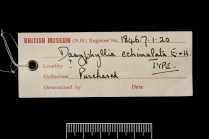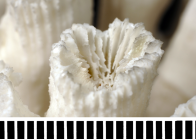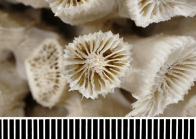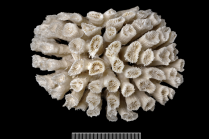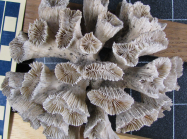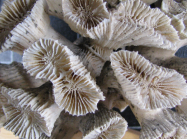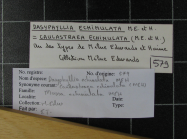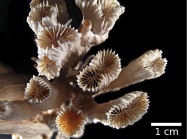WoRMS taxon details
Caulastraea Dana, 1846
267299 (urn:lsid:marinespecies.org:taxname:267299)
accepted
Genus
Caulastraea furcata Dana, 1846 (type by subsequent designation)
Caulastrea Dana, 1846 · unaccepted > misspelling
Caulastrea Vaughan & Wells, 1943 † · unaccepted > unavailable name (nomen nullum)
Cricotheca Quenstedt, 1881 † · unaccepted > junior subjective synonym
Dasyphyllia Milne Edwards & Haime, 1849 · unaccepted > junior subjective synonym
Eusmilia (Caulastraea) Dana, 1846 · unaccepted > superseded combination
- Species Caulastraea echinulata (Milne Edwards & Haime, 1849)
- Species Caulastraea furcata Dana, 1846
- Species Caulastraea aiharai Yabe & Sugiyama, 1935 accepted as Caulastraea echinulata (Milne Edwards & Haime, 1849) (unaccepted > junior subjective synonym)
- Species Caulastraea conglobata Yabe & Sugiyama, 1932 accepted as Astraeosmilia tumida (Matthai, 1928) (unaccepted > junior subjective synonym)
- Species Caulastraea connata (Ortmann, 1892) accepted as Astraeosmilia connata Ortmann, 1892 (unaccepted > superseded combination)
- Species Caulastraea curvata Wijsman-Best, 1972 accepted as Astraeosmilia curvata (Wijsman-Best, 1972) (unaccepted > superseded combination, basionym)
- Species Caulastraea distorta Dana, 1846 accepted as Caulastraea furcata Dana, 1846 (unaccepted > junior subjective synonym)
- Species Caulastraea multiseptata Yabe & Sugiyama, 1931 accepted as Astraeosmilia tumida (Matthai, 1928) (unaccepted > junior subjective synonym)
- Species Caulastraea plana (Hodgson & Ross, 1982) accepted as Astraeosmilia tumida (Matthai, 1928) (unaccepted > junior subjective synonym)
- Species Caulastraea tumida Matthai, 1928 accepted as Astraeosmilia tumida (Matthai, 1928) (unaccepted > superseded combination, basionym)
- Species Caulastraea yokoyamai Yabe & Sugiyama, 1931 accepted as Astraeosmilia tumida (Matthai, 1928) (unaccepted > junior subjective synonym)
- Species Caulastraea simplex Crossland, 1952 (uncertain > taxon inquirendum)
- Species Caulastraea undulata Dana, 1846 (uncertain > taxon inquirendum)
marine, fresh, terrestrial
Dana, J.D. (1846-1849). Zoophytes. United States Exploring Expedition during the years 1838-1842. <em>Lea and Blanchard, Philadelphia.</em> 7: 1-740, 61 pls. (1846: 1-120, 709-720; 1848: 121-708, 721-740; 1849: atlas pls. 1-61)., available online at http://www.sil.si.edu/digitalcollections/usexex/navigation/ScientificText/USExEx19_08select.cfm [details]
Description 'Segregato-gemmate, cespitose, with the stems and calicles subcylindrical. Coralla fragile, exterior excavate; lamellae...
Status This genus is often misspelled "Caulastrea".
Description 'Segregato-gemmate, cespitose, with the stems and calicles subcylindrical. Coralla fragile, exterior excavate; lamellae unequally exsert, subentire, very numerous.' (Dana, 1846: 197) [details]
Status This genus is often misspelled "Caulastrea".
Status This genus is often misspelled "Caulastrea". [details]
Hoeksema, B. W.; Cairns, S. (2024). World List of Scleractinia. Caulastraea Dana, 1846. Accessed through: World Register of Marine Species at: https://www.marinespecies.org/aphia.php?p=taxdetails&id=267299 on 2024-04-19
Date
action
by
![]() The webpage text is licensed under a Creative Commons Attribution 4.0 License
The webpage text is licensed under a Creative Commons Attribution 4.0 License
original description
Dana, J.D. (1846-1849). Zoophytes. United States Exploring Expedition during the years 1838-1842. <em>Lea and Blanchard, Philadelphia.</em> 7: 1-740, 61 pls. (1846: 1-120, 709-720; 1848: 121-708, 721-740; 1849: atlas pls. 1-61)., available online at http://www.sil.si.edu/digitalcollections/usexex/navigation/ScientificText/USExEx19_08select.cfm [details]
original description (of Dasyphyllia Milne Edwards & Haime, 1849) Milne Edwards H, Haime J. (1849). Mémoire sur les Polypes appartenant à la famille des Oculinides, au groupe intermédiaire des Pseudastréides et à la famille des Fongides. <em>Comptes rendus hebdomadaires des séances de l'Académie des sciences, Paris.</em> 29: 67-73., available online at https://biodiversitylibrary.org/page/1225794 [details]
original description (of Cricotheca Quenstedt, 1881 †) Quenstedt, F. A. (1878-1881). Petrefactenkunde Deutschlands. Röhren- und Sternkorallen. <em>Leipzig: Fues Verlag.</em> 6: 1-1081., available online at https://sachsen.digital/werkansicht?tx_dlf[id]=29785&tx_dlf[page]=1 [details]
original description (of Caulastrea Vaughan & Wells, 1943 †) Vaughan TW, Wells JW. (1943). Revision of the suborders, families and genera of the Scleractinia. <em>Special Papers of the Geological Society of America.</em> 44: 1-363. [details]
basis of record Budd AF, Fukami H, Smith ND, Knowlton N. (2012). Taxonomic classification of the reef coral family Mussidae (Cnidaria: Anthozoa: Scleractinia). <em>Zoological Journal of the Linnean Society.</em> 166 (3): 465-529., available online at https://doi.org/10.1111/j.1096-3642.2012.00855.x [details]
additional source Matthai G. (1928). A Monograph of the Recent meandroid Astraeidae. <em>Catalogue of the Madreporarian Corals in the British Museum (Natural History).</em> 7: 1-288, pls. 1-72. [details] Available for editors [request]
[request]
additional source Huang D, Benzoni F, Fukami H, Knowlton N, Smith ND, Budd AF (2014) Taxonomic classification of the reef coral families Merulinidae, Montastraeidae, and Diploastraeidae (Cnidaria: Anthozoa: Scleractinia). Zoological Journal of the Linnean Society 171: 277–355. [details]
additional source Chevalier J-P. (1961). Recherches sur les Madreporaires et les formations recifales Miocenes de la Mediterranee occidentale. <em>Memoires de la Societe Geologique de France, Nouvelle Série.</em> 40(93): 1-562, pls. 1-26. [details]
additional source Dana, J. D. (1846-1847). On Zoophytes. <em>The American Journal of Science and Arts, Second Series.</em> 2(4): 64-69; 2(5): 187-202; 3(7): 1-24; 3(8): 160-163; 3(9): 337-347. New-Haven., available online at https://www.biodiversitylibrary.org/page/28135503 [details]
additional source Veron JEN. (2000). Corals of the World. Vol. 1–3. <em>Australian Institute of Marine Science and CRR, Queensland, Australia.</em> [details]
original description (of Dasyphyllia Milne Edwards & Haime, 1849) Milne Edwards H, Haime J. (1849). Mémoire sur les Polypes appartenant à la famille des Oculinides, au groupe intermédiaire des Pseudastréides et à la famille des Fongides. <em>Comptes rendus hebdomadaires des séances de l'Académie des sciences, Paris.</em> 29: 67-73., available online at https://biodiversitylibrary.org/page/1225794 [details]
original description (of Cricotheca Quenstedt, 1881 †) Quenstedt, F. A. (1878-1881). Petrefactenkunde Deutschlands. Röhren- und Sternkorallen. <em>Leipzig: Fues Verlag.</em> 6: 1-1081., available online at https://sachsen.digital/werkansicht?tx_dlf[id]=29785&tx_dlf[page]=1 [details]
original description (of Caulastrea Vaughan & Wells, 1943 †) Vaughan TW, Wells JW. (1943). Revision of the suborders, families and genera of the Scleractinia. <em>Special Papers of the Geological Society of America.</em> 44: 1-363. [details]
basis of record Budd AF, Fukami H, Smith ND, Knowlton N. (2012). Taxonomic classification of the reef coral family Mussidae (Cnidaria: Anthozoa: Scleractinia). <em>Zoological Journal of the Linnean Society.</em> 166 (3): 465-529., available online at https://doi.org/10.1111/j.1096-3642.2012.00855.x [details]
additional source Matthai G. (1928). A Monograph of the Recent meandroid Astraeidae. <em>Catalogue of the Madreporarian Corals in the British Museum (Natural History).</em> 7: 1-288, pls. 1-72. [details] Available for editors
additional source Huang D, Benzoni F, Fukami H, Knowlton N, Smith ND, Budd AF (2014) Taxonomic classification of the reef coral families Merulinidae, Montastraeidae, and Diploastraeidae (Cnidaria: Anthozoa: Scleractinia). Zoological Journal of the Linnean Society 171: 277–355. [details]
additional source Chevalier J-P. (1961). Recherches sur les Madreporaires et les formations recifales Miocenes de la Mediterranee occidentale. <em>Memoires de la Societe Geologique de France, Nouvelle Série.</em> 40(93): 1-562, pls. 1-26. [details]
additional source Dana, J. D. (1846-1847). On Zoophytes. <em>The American Journal of Science and Arts, Second Series.</em> 2(4): 64-69; 2(5): 187-202; 3(7): 1-24; 3(8): 160-163; 3(9): 337-347. New-Haven., available online at https://www.biodiversitylibrary.org/page/28135503 [details]
additional source Veron JEN. (2000). Corals of the World. Vol. 1–3. <em>Australian Institute of Marine Science and CRR, Queensland, Australia.</em> [details]
 Present
Present  Inaccurate
Inaccurate  Introduced: alien
Introduced: alien  Containing type locality
Containing type locality
From editor or global species database
Comparison Molecular and morphological data support Caulastraea, Mycedium, Oulophyllia and Pectinia as a monophyletic group (subclade XVII-D/E; Huang et al., 2011; Arrigoni et al., 2012), even though they differ in almost one-third of all macromorphological characters examined. Subcorallite characters, including DNA sequences, are therefore the main source of synapomorphies for this clade. Caulastraea is a well-defined and well-supported genus. The phaceloid colony form, weak or moderate septal lobes and low tooth height are identified as synapomorphies that clearly distinguish it from the above closely-related genera. It is the only Merulinidae genus with phaceloid attached colonies and possesses septal lobes that are not as well developed as those in Coelastrea, Goniastrea and Trachyphyllia. [details]Description 'Segregato-gemmate, cespitose, with the stems and calicles subcylindrical. Coralla fragile, exterior excavate; lamellae unequally exsert, subentire, very numerous.' (Dana, 1846: 197) [details]
Diagnosis Colonial, with intracalicular budding only. Corallites monomorphic and discrete (1–3 centers); monticules absent. Phaceloid. Calice width medium (4–15 mm), with medium relief (3–6 mm). Septa in 3 cycles (24–36 septa). Free septa present but irregular. Septa spaced < 6 septa per 5 mm. Costosepta equal in relative thickness. Columellae trabecular and spongy (> 3 threads), < 1/4 of calice width, and continuous among adjacent corallites. Paliform (uniaxial) and septal (multiaxial) lobes weak or moderate. Epitheca absent and endotheca abundant (vesicular). Tooth base at mid-calice circular. Tooth tip at mid-calice irregular; tip orientation perpendicular to septum. Tooth height low (< 0.3 mm) and tooth spacing medium (0.3–1 mm), with > 6 teeth per septum. Granules scattered on septal face; irregular in shape. Interarea palisade. Walls formed by dominant paratheca; abortive septa absent. Thickening deposits fibrous. Costa center clusters not distinct; medial lines strong. Septum center clusters not distinct; medial lines strong. Transverse crosses present. Columella centers clustered. [details]
Remark This genus was established by Dana, 1846: 197 as part of the family Astraeidae Dana, 1846: 154 (see also Matthai, 1928: 272–273). He posited that Caulastraea is affiliated to Caryophyllia Lamarck, 1801: 370 and Mussa Oken, 1815: 73 (Dana, 1846: 198), placing it in a subdivision comprising corals that are massive ('glomerate') or 'calicularly branched' (Dana, 1846: 157). This united Caulastraea with a diverse group of genera, including Tridacophyllia de Blainville, 1830: 327 (= Pectinia de Blainville, 1825: 201), Astrea Lamarck, 1801: 371, and Monticularia Lamarck, 1816: 248 (= Hydnophora Fischer von Waldheim, 1807: 295), all of which are currently in Merulinidae. This association persisted for almost a century before Pectiniidae Vaughan and Wells, 1943: 196 was erected for Pectinia and Mycedium, among others, and Caulastraea transferred to Faviidae Gregory, 1900: 29. This genus is relatively well sampled, with only Caulastraea connata yet to be placed on the phylogeny. It was only recently that Veron, 2000, vol. 3: 91 synonymized Astraeosmilia Ortmann, 1892: 664 as Caulastraea Dana, 1846: 197, resulting in the genus change of Astraeosmilia connata Ortmann, 1892: 664. [details]
Status This genus is often misspelled "Caulastrea". [details]
| Language | Name | |
|---|---|---|
| English | trumpet coral [from synonym]candy coral [from synonym]bullseye coral [from synonym] | [details] |
| Japanese | タバネサンゴ属 | [details] |
